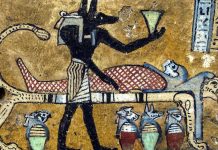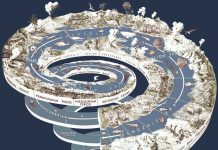Stonehenge is a megalithic monument on the Salisbury Plain in Southern England, composed mainly of thirty upright stones (sarsens, each over ten feet tall and weighing 26 tons), aligned in a circle, with thirty lintels (6 tons each) perched horizontally atop the sarsens in a continuous circle. There is also an inner circle composed of similar stones, also constructed in post-and-lintel fashion.
Constructed without the use of draft animals and shaped by stone tools, Stonehenge was erected many miles from the quarry from which the stones came. It is an amazing feat of engineering, and many stories, both old ones and retellings, frequently name Merlin as this engineer. This is due largely to one Gerald of Wales (Giraldus Cambrensis), a historian of the 12th century, who wrote a book titled The History and Topography of Ireland.
Gerald called Stonehenge “The Giant’s Dance,” because he had heard stories that giants brought the stones from Africa to Ireland, and built the monument (by some accounts on Mount Kildare, and by others “at Ophela, near the castle of Nas” (O’Meara, ). Later, Gerald said, Aurelius Ambrosius, king of the Britons, had Merlin bring the stones to Britain.
However, the archaeological evidence at Stonehenge simply does not support an Arthurian date of construction. The archaeology points to a construction date between 5,000 and 3,000 years ago (more than likely, several construction dates over this time). Stonehenge is angled such that on the equinoxes and the solstices, the sun rising over the horizon appears to be perfectly placed between gaps in the megaliths. This is doubtless not an accident, and probably contributed to the stories of its mysterious origins.
In the 1940s and 1950s, Richard John Copland Atkinson proposed that construction occurred in three phases, which he labelled Stonehenge I, II, IIIa, IIIb, and IIIc. This sequence has recently been revised in Archaeological Report (10) published by English Heritage.Phase I (2950-2900 BCE)
Stonehenge: Eclipse Computer?
Plan of Stonehenge with the Aubrey holes, the Heel Stone, and the Station Stones 91, 92, 93, 94 marked (image from Rodney Castleden The Making of Stonehenge. London and New York: Routledge, 1993. p. 30)
Gerald Hawkins, a Professor of Astronomy, concluded that Stonehenge was a sophisticated astronomical observatory designed to predict eclipses (Stonehenge Decoded). The positioning of the stones provides a wealth of information, as does the choice of the site itself. If you can see the alignment, general relationship, and the use of these stones then you will know the reason for the construction. The author, and other astronomers, discovered the 56-year cycle of eclipses by decoding Stonehenge!
The movement of stones once each year from an initial fixed position allows to predict accurately every important lunar event for hundreds of years. This computer would need resetting about once every 300 years by advancing the stones by one space. Mankind generally used the cycle of the moon as a unit of timekeeping.
Every year on the first day of summer, the Sun rises at a point that is farther north than on any other day of the year. At the ruins of Stonehenge in England, this solstice sunrise appears on the horizon in direct alignment with the massive heel stone. This is the most outstanding feature of this ancient monument, built during the same era as the Great Pyramid of Egypt. There is little doubt that the builders of Stonehenge used it to mark this special day as the beginning of each year. By counting the number of days between these annual alignments, they could determine the length of the year. This could serve as a practical calendar to mark holidays and seasonal festivals and to ensure the timely planting and harvesting of crops.
But to predict eclipses, knowledge of two other cycles is required. One of these — the length of the lunar month — is easily determined. It is simply the number of days between one full Moon and the next. This cycle of 29-1/2 days is marked at Stonehenge by two rings of 29 and 30 holes, which together average 29-1/2. The other cycle, however, is of an altogether different character: it is a cycle of rotation of two invisible points in space. The evidence shows that the builders of Stonehenge probably discovered this cycle and could have used it to predict eclipses.
These two invisible points in space are called the lunar nodes (from the Latin for “knot”). They are the points where the Moon’s orbit, which is tilted at a slight angle, intersects the plane of the Earth’s orbit. It would have taken many decades of watching countless risings and settings of the Moon to figure out the cycle of the lunar nodes. This information — which must have been passed on from generation to generation — is preserved at Stonehenge. All the Moon alignments necessary for determining this cycle are marked by massive stones.
Who were these people who observed this subtle cycle even before the first metal tools were used by humankind? Some have suggested that Stonehenge was built by Druids, but we don’t really know much about the builders. We do know that the actual motions of the Sun and the Moon are reflected in the structure of Stonehenge, and we can reason how it may have been used to keep track of these cycles. The number of stones or holes in the ground in the various rings around Stonehenge each represents a certain number of days or years in the cycles. By moving markers (such as stones) around a ring in time with the cycles, the positions of the Sun and Moon — and the two invisible points — can be tracked.
An eclipse can occur only when the Sun is close to being aligned with a node. By using Stonehenge to keep track of the position of the Sun and the nodes, these “danger periods” for eclipses can be predicted. A new (or full) Moon appearing during one of these periods would call for a special vigil to see if the solar (or lunar) eclipse would be visible from Stonehenge. A total solar eclipse would be a rarity. But the law of averages confirms that either a partial solar eclipse or a lunar eclipse can be seen (weather permitting) from the same point on the Earth about once every year.
Why would eclipses have been so important to the ancient people of Stonehenge? Perhaps they considered the darkening of the Sun or the Moon a fearsome event — a celestial omen of doom or disaster. Many cultures have interpreted eclipses this way. But the sophistication of the astronomy of Stonehenge suggests that the builders had something different in mind. Their understanding of the solar and lunar cycles must have led to a high regard for the cosmic order. Eclipses may have been seen as affirmations of the regularity of these cycles. Or perhaps the unseen lunar nodes formed an element of their religion as invisible gods capable of eclipsing the brightest objects in the heavens.
The idea that Stonehenge may have been a center for some kind of worship has occurred to many. It is not hard to imagine Stone Age people gathering at a “sacred place” at “sacred times” (such as solstices, equinoxes, and eclipses) to reaffirm their religious beliefs through ritual practices. British antiquarian Dr. William Stukeley, who in 1740 was the first to note the summer solstice alignment at Stonehenge, advanced the notion that the monument was built by Druids to worship the serpent. He claimed that Stonehenge and similar stone circles had been serpent temples, which he called “Dracontia.” Could this serpent symbolism be related to eclipses? Recall that the key to eclipses is the position of the lunar nodes. The length of time for the Moon to return to a node (about 27.2 days) astronomers call the draconic month. (Draco is the Latin word for “serpent” or “dragon.) Perhaps the mythical serpents of Stonehenge and the legendary dragon that eats the Sun are symbols of the same thing: the invisible presence in time and space that eclipses the Sun and the Moon.



































